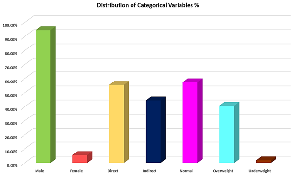Body Mass Index as a Determinant of Inguinal Hernia Type: A Clinical Analysis
Authors
##plugins.themes.bootstrap3.article.main##
Abstract
Background: Inguinal hernias are among the most frequent conditions encountered surgically worldwide. It is hypothesized that body mass index (BMI) is involved in the occurrence and distribution pattern of types of hernias, yet the relationship is debated. Objectives: This study sought to establish the relationship between the type of inguinal hernia and BMI and determine the significance of age and sex as covariates. The research question addressed was: Does BMI strongly predict the occurrence of direct inguinal hernia against the occurrence of indirect inguinal hernia in adults? Methods: An observational retrospective study was carried out between January 2024 and September 2025 at Karuna Medical College, located at Vilayodi, Chittur, Palakkad. The research signed up a total of 54 adult patients with unilateral inguinal hernia. The demographic and anthropometric information was extracted from medical records and then entered into Microsoft Excel 2016 and statistical analysis was carried out using R Studio. Analytical methods applied included descriptive statistics, the Mann–Whitney U test, chi-square test, Spearman correlation, and logistic regression analysis. Results: Cohort age was 56.84 ± 14.84 years and BMI was 24.41 ± 3.08 kg/m². Direct hernia was dominant (55.56%) over indirect hernia (44.44%). Significant difference in BMI was observed between direct and indirect hernia groups (p=0.0281). Logistic regression established BMI as an independent correlate of direct hernia (OR=1.29, 95% CI: 1.04–1.59, p=0.0205). No significant correlation was noted between type of hernia and age and sex. Conclusion: Increased BMI was strongly associated with direct inguinal hernia, and it suggests broader body weight distribution as a probable dominant factor amongst patients for this subtype. These findings highlight the importance of considering the BMI for risk stratification and preoperative evaluation of patients with hernias. Large-scale, multicentric studies are recommended for strengthening the evidence.
##plugins.themes.bootstrap3.article.details##
Copyright (c) 2025 Palaniappan Swaminathan, Sukanya M, Sanjeedh Ahamed, Swathi, Ameega Fathima, Fathima Basheer

This work is licensed under a Creative Commons Attribution 4.0 International License.
Creative Commons License All articles published in Annals of Medicine and Medical Sciences are licensed under a Creative Commons Attribution 4.0 International License.
Palaniappan Swaminathan, Department of General Surgery, Karuna Medical College, Vilayodi, Chittur, Palakkad, Kerala, 678103, India.
Department of General Surgery, Karuna Medical College, Vilayodi, Chittur, Palakkad, Kerala, 678103, India.
Sukanya M, Department of General Surgery, Karuna Medical College, Vilayodi, Chittur, Palakkad, Kerala, 678103, India.
Department of General Surgery, Karuna Medical College, Vilayodi, Chittur, Palakkad, Kerala, 678103, India.
Sanjeedh Ahamed, CRMI, General Surgery, Karuna Medical College, Vilayodi, Chittur, Palakkad, Kerala, 678103, India.
CRMI, General Surgery, Karuna Medical College, Vilayodi, Chittur, Palakkad, Kerala, 678103, India.
Swathi, Data Analyst & Statistician, Department of Medical Research, Karuna Medical College, Vilayodi, Chittur, Palakkad, Kerala, 678103, India.
Data Analyst & Statistician, Department of Medical Research, Karuna Medical College, Vilayodi, Chittur, Palakkad, Kerala, 678103, India.
Ameega Fathima, Final Year MBBS Student, Karuna Medical College, Vilayodi, Chittur, Palakkad, Kerala, 678103, India.
Final Year MBBS Student, Karuna Medical College, Vilayodi, Chittur, Palakkad, Kerala, 678103, India.
Fathima Basheer, Final Year MBBS Student, Karuna Medical College, Vilayodi, Chittur, Palakkad, Kerala, 678103, India.
Final Year MBBS Student, Karuna Medical College, Vilayodi, Chittur, Palakkad, Kerala, 678103, India.
[1] Li J, Wu L, Shao X. Impact of body fat location and volume on incisional hernia development and its outcomes following repair. ANZ Journal of Surgery. 2024 May;94(5):804-10.
[2] Liu JK, Purdy AC, Moazzez A, La Riva A, Ozao-Choy J. Defining a body mass index threshold for preventing recurrence in ventral hernia repairs. The American Surgeon. 2022 Oct;88(10):2514-8.
[3] Mabeza RM, Cho NY, Vadlakonda A, Sakowitz S, Ebrahimian S, Moazzez A, Benharash P. Association of body mass index with morbidity following elective ventral hernia repair. Surgery Open Science. 2023 Aug 1;14:11-6.
[4] Abebe MS, Tareke AA, Alem A, Debebe W, Beyene A. Worldwide magnitude of inguinal hernia: Systematic review and meta-analysis of population-based studies. SAGE Open Medicine. 2022 Nov;10:20503121221139150.
[5] Shi H, Peng X, Lin Y, Song H, Liu L, Zeng Y, He B, Gu Y. Association between different obesity metrics and risk of inguinal hernia. Updates in Surgery. 2025 Apr;77(2):567-74.
[6] Hemberg A, Montgomery A, Holmberg H, Nordin P. Waist circumference is not superior to body mass index in predicting groin hernia repair in either men or women. World Journal of Surgery. 2022 Feb;46(2):401-8.
[7] Rosca R, Paduraru DN, Bolocan A, Musat F, Ion D, Andronic O. A Comprehensive Review of Inguinal Hernia occurrence in obese individuals. Maedica. 2023 Dec;18(4):692.
[8] Shrestha S, Upadhyay PK. Prevalence of obesity in inguinal hernia repair patients in a tertiary care center. JNMA: Journal of the Nepal Medical Association. 2021 Feb 28;59(234):156.
[9] Melwani R, Malik SJ, Arija D, Sial I, Bajaj AK, Anwar A, Hashmi AA. Body mass index and inguinal hernia: an observational study focusing on the association of inguinal hernia with body mass index. Cureus. 2020 Nov 10;12(11).
[10] Bharata B, Triarta G. The relationship between obesity and obstruction risk of lateral inguinal hernia at Negara general hospital in 2019-2020. International Journal of Research in Medical Sciences. 2020 Dec;8(12):4247-50.
[11] Zelicha H, Bell DS, Chen D, Chen Y, Livingston EH. Obesity and abdominal hernia in ambulatory patients, 2018–2023. Hernia. 2024 Aug;28(4):1317-24.
[12] Huerta S, Tran N, Yi B, Pham T. Outcomes of obese compared to non-obese veterans undergoing open inguinal hernia repair: a case–control study. Hernia. 2021 Oct;25(5):1289-94.
[13] Pivo S, Huynh D, Oh C, Towfigh S. Sex-based differences in inguinal hernia factors. Surgical endoscopy. 2023 Nov;37(11):8841-5.
[14] Cowan B, Kvale M, Yin J, Patel S, Jorgenson E, Mostaedi R, Choquet H. Risk factors for inguinal hernia repair among US adults. Hernia. 2023 Dec;27(6):1507-14.
[15] Park CL, Chan PH, Prentice HA, Sucher K, Brill ER, Paxton EW, Laxa B. Risk factors for reoperation following inguinal hernia repair: results from a cohort of patients from an integrated healthcare system. Hernia. 2023 Dec;27(6):1515-24.

